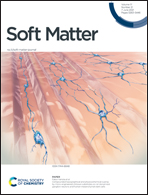A simulation study of the self-assembly of ABC star terpolymers confined between two parallel surfaces†
Abstract
The phase behavior of ABC star terpolymers confined between two identical parallel surfaces is systematically studied using a simulated annealing method. Several phase diagrams are constructed for systems with different bulk phases or with different interfacial interaction strength ratios in the space of surface distance (D) and surface preference for different arms, or in the space of D and the arm-length ratio x. Phases, including tiling patterns [6.6.6], [8.8.4], [8.6.6; 8.6.4], [8.6.6; 8.6.4; 10.6.6; 10.6.4] and hierarchical lamellar structures of lamella + cylinders and lamella + rods, are identified both in the bulk and in the films. Our results suggest that the self-assembled structure of a phase is largely controlled by x, while an increase of the interfacial interaction strength ratio shifts the x-window for each phase to the smaller x side. The orientation of a confined phase depends on the “effective surface preference” which is a combined effect of the interfacial interaction strength ratio, the surface preference, and the entropic preference. In the case of neutral or weak “effective surface preference”, phases with a perpendicular orientation are usually observed, while in the case of strong “effective surface preference” phases with a perpendicular orientation or also with outermost wetting-layers can be frequently observed under some circumstances.



 Please wait while we load your content...
Please wait while we load your content...